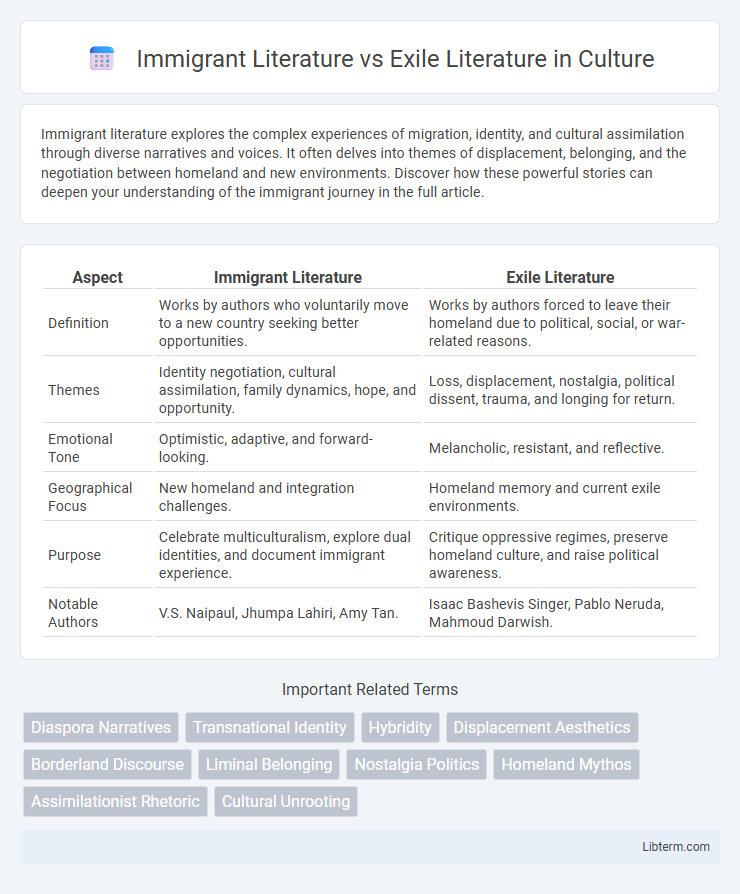Immigrant literature explores the complex experiences of migration, identity, and cultural assimilation through diverse narratives and voices. It often delves into themes of displacement, belonging, and the negotiation between homeland and new environments. Discover how these powerful stories can deepen your understanding of the immigrant journey in the full article.
Table of Comparison
| Aspect | Immigrant Literature | Exile Literature |
|---|---|---|
| Definition | Works by authors who voluntarily move to a new country seeking better opportunities. | Works by authors forced to leave their homeland due to political, social, or war-related reasons. |
| Themes | Identity negotiation, cultural assimilation, family dynamics, hope, and opportunity. | Loss, displacement, nostalgia, political dissent, trauma, and longing for return. |
| Emotional Tone | Optimistic, adaptive, and forward-looking. | Melancholic, resistant, and reflective. |
| Geographical Focus | New homeland and integration challenges. | Homeland memory and current exile environments. |
| Purpose | Celebrate multiculturalism, explore dual identities, and document immigrant experience. | Critique oppressive regimes, preserve homeland culture, and raise political awareness. |
| Notable Authors | V.S. Naipaul, Jhumpa Lahiri, Amy Tan. | Isaac Bashevis Singer, Pablo Neruda, Mahmoud Darwish. |
Defining Immigrant Literature and Exile Literature
Immigrant literature encompasses narratives produced by individuals who relocate voluntarily to a new country, often exploring themes of adaptation, identity negotiation, and cultural hybridity within diasporic communities. Exile literature, on the other hand, arises from forced displacement due to political persecution, war, or oppression, emphasizing loss, alienation, and the longing for homeland. Both literary categories examine displacement but diverge in the circumstances of migration and the emotional and political contexts shaping the authors' experiences.
Historical Evolution of Both Genres
Immigrant literature emerged prominently in the late 19th and early 20th centuries, reflecting the experiences of individuals who migrated voluntarily for economic opportunities or better living conditions, often highlighting themes of assimilation and identity formation. Exile literature, by contrast, gained significant traction during and after major political upheavals in the 20th century, such as World War II and various totalitarian regimes, focusing on forced displacement, loss, and nostalgia for the homeland. Both genres evolved in response to historical events shaping migration patterns, with immigrant literature emphasizing integration into new societies while exile literature foregrounds political persecution and the trauma of separation.
Core Themes and Motifs
Immigrant Literature centers on themes of identity negotiation, cultural hybridity, and the search for belonging within new sociocultural environments, often highlighting the challenges of assimilation and intergenerational conflicts. Exile Literature grapples with displacement, loss, nostalgia, and the trauma of forced separation from one's homeland, emphasizing memory, alienation, and political or spiritual exile. Both literatures explore the motif of journey and liminality, but Immigrant Literature tends to foreground integration and adaptation, while Exile Literature focuses on estrangement and the persistent connection to a lost home.
Identity, Belonging, and Displacement
Immigrant literature explores themes of identity reshaped by voluntary migration, emphasizing hybrid cultural belonging and the negotiation between homeland and host society. Exile literature often centers on involuntary displacement, reflecting loss, alienation, and a fractured sense of self tied to political or forced exile. Both genres grapple with displacement, but immigrant literature leans toward integration and bicultural identity, while exile literature foregrounds trauma and rupture in belonging.
Language and Multicultural Expression
Immigrant literature often explores the negotiation between native and adopted languages, highlighting bilingualism and code-switching as tools for identity formation and cultural hybridity. Exile literature emphasizes language as a site of loss and resistance, where the displacement from homeland is reflected through fragmented narratives and the preservation of ancestral linguistic elements. Both genres showcase multicultural expression, yet immigrant literature leans toward integration and fusion, while exile literature foregrounds nostalgia and the trauma of dislocation.
Representation of Home and Homeland
Immigrant literature often portrays home as a mutable, hybrid space shaped by cultural negotiation and adaptation, reflecting the complex identities formed in diaspora. Exile literature emphasizes a more static, idealized vision of homeland, marked by nostalgia and loss due to forced displacement or political estrangement. The representation of home in immigrant literature is dynamic and reconstructive, while exile literature tends to preserve an unchanging, often mythologized homeland.
Political Contexts and Motivations
Immigrant literature often emerges from voluntary migration driven by economic or personal aspirations, reflecting themes of identity negotiation and cultural adaptation within new political environments. Exile literature primarily arises from forced displacement due to political persecution, war, or authoritarian regimes, emphasizing loss, resistance, and critiques of oppressive power structures. Political contexts in exile literature intensify narratives of homeland trauma and activism, while immigrant literature navigates the complexities of integration and multiculturalism.
Author Perspectives and Lived Experiences
Immigrant literature often reflects authors' negotiations of identity and belonging within a new cultural context, emphasizing themes of adaptation, hybridity, and transformation. Exile literature, by contrast, typically conveys a profound sense of loss, displacement, and political or forced removal, foregrounding themes of nostalgia, trauma, and alienation. Both genres offer essential perspectives on migration but diverge in the nature of authors' lived experiences, with immigrant writers focusing on integration and exile writers on rupture and survival.
Reception and Impact in Global Literature
Immigrant literature and exile literature have distinct receptions shaped by their unique cultural contexts and historical circumstances, influencing global literary landscapes differently. Immigrant literature often gains recognition for its exploration of identity, assimilation, and multiculturalism, impacting multicultural discourse and broadening narratives in host countries. Exile literature resonates deeply with themes of loss, displacement, and political dissent, profoundly affecting global awareness of historical injustices and enriching world literature with diverse political and emotional perspectives.
Future Trends in Immigrant and Exile Literary Narratives
Future trends in immigrant and exile literary narratives emphasize hybrid identities and transnational experiences, reflecting ongoing globalization and displacement. Digital platforms enable marginalized voices to reach global audiences, fostering diverse storytelling methods and interactive narratives. Themes of cultural memory, negotiation of belonging, and political resistance continue to evolve, highlighting the dynamic interplay between personal histories and collective memory.
Immigrant Literature Infographic

 libterm.com
libterm.com